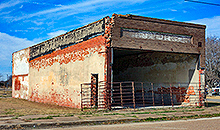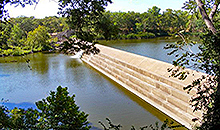Main Menu
Limestone County Data
Limestone County Communities & Places
Genealogy & History Links by USGHN
Important Limestone County Addresses
Sponsors
Limestone County Neighbors
Falls County, Texas
Freestone County, Texas
Hill County, Texas
Leon County, Texas
McLennan County, Texas
Navarro County, Texas
Robertson County, Texas
Other Websites
Welcome to Limestone County Texas Genealogy & History Network!
Welcome to the Limestone County, Texas Genealogy & History Network. Our purpose is to provide visitors with free resources for genealogical and historical research. To share your genealogy or history information, send an email to txghn@outlook.com and we will happily include it here. For other Texas Counties, visit the Texas Genealogy & History Network state website and go to the appropriate county. Thanks for visiting and good luck with your research! |
|
About Limestone County, Texas...

Limestone County is in Central Texas about thirty miles due east of Waco. The vegetation in the county includes mesquite, blackjack oak, pecan, bois d'arc, and elm trees as well as Indian grass and Texas winter grass in the northern area; the Post Oak Savannah vegetation of the southern area has tall grasses, Post oak, and blackjack oak.
The area that became Limestone County was home to the Tawakoni, or Tehuacana, and Waco Indians. These were primarily agrarian people friendly to the whites who settled there. Tehuacana, in northeastern Limestone County, is on an old Indian village site. Limestone County was part of the Haden Edwards and Robert Leftwichqqv empresario grants made by the Coahuila and Texas legislature in 1825. This legislation began settlement of the area and the struggle between the government of Mexico and the American settlers for dominance. The government tried to restrict colonization through legislation, but settlers continued to come to Texas.
Fort Parker, near the Navasota River in what is now central Limestone County, was the earliest actual settlement in the vicinity. While most of the men were out in the fields early on May 19, 1836, a large band of Comanches and their Kiowa allies approached the fort. After a short conversation under a flag of truce, the Indians attacked and killed most of the inhabitants. Several prisoners were taken, including Mrs. Rachel Plummer, who later wrote an account of her captivity, and nine-year-old Cynthia Ann Parker, who spent the next twenty-four years with the Comanches and married Peta Nocona. Their son, Quanah Parker, was a chief of the tribe. After this raid further settlement was delayed until a treaty with the Indians was signed in 1844 at the instigation of Sam Houston.
On April 11, 1846, Limestone County was formed from Robertson County, and a week later Springfield was established as the county seat. When the courthouse burned and the Houston and Texas Central  Railway bypassed the town, an election was ordered and Groesbeck became the county seat. The organization of the county was completed on August 18, 1846, with the election of county officials. Limestone County originally included all the land between the Brazos and Trinity rivers on the east and west, and the land north of Robertson County to Navarro County. In 1848 part of northern and western Limestone County was taken to form McLennan and Falls counties, and in 1850 part of the eastern section was taken to form part of Freestone County. The boundaries were changed to their present form on November 2, 1866.
Railway bypassed the town, an election was ordered and Groesbeck became the county seat. The organization of the county was completed on August 18, 1846, with the election of county officials. Limestone County originally included all the land between the Brazos and Trinity rivers on the east and west, and the land north of Robertson County to Navarro County. In 1848 part of northern and western Limestone County was taken to form McLennan and Falls counties, and in 1850 part of the eastern section was taken to form part of Freestone County. The boundaries were changed to their present form on November 2, 1866.
After the Civil War the majority of whites in Limestone County strongly opposed congressional Reconstruction. Many race-related murders took place in the county during the 1870s. The situation  became so strained that the governor declared the county under martial law. Though the election went on as scheduled in the county, the state board rejected the returns because of reported violence.
became so strained that the governor declared the county under martial law. Though the election went on as scheduled in the county, the state board rejected the returns because of reported violence.
Gas was discovered in 1913. Drilling tests were performed near Mexia after the discovery at Spindletop, additional test wells were drilled, and in November 1920 oil was discovered. The oilfields brought wealth to the area. During the Great Depression of the 1930s the county went into a decline. Because many tenant farmers left the land and moved to the cities in search of jobs, the population and agricultural production declined. Recreation and tourism are important in the economic life of the county. However, the area is still predominantly ranch and farm country. Overgrazing and water erosion are environmental problems.
The county has a total area of 933 square miles, of which 905 square miles is land and 28 square miles  (3.0%) is water. The population recorded in the 1850 Federal Census was 2,608. The population peaked in 1930 at 39,497. The 2010 census recorded 23,384 residents in the county.
(3.0%) is water. The population recorded in the 1850 Federal Census was 2,608. The population peaked in 1930 at 39,497. The 2010 census recorded 23,384 residents in the county.
Neighboring counties are Navarro County (north), Freestone County (northeast), Leon County (southeast), Robertson County (south), Falls County (southwest), McLennan County (west), and Hill County (northwest). The county seat is Groesbeck. Other communities in the county include Mexia, Coolidge, Kosse, Tehuacana, Thornton, Ben Hur, Buffalo Mop, Forest Glade, Prairie Hill, and Springfield.
Limestone County, Texas Records
Birth Records - The Texas Department of State Health Services has records from 1903 to present. Records for the last 75 years considered private and will only be provided to certain individuals. To obtain current information on who may obtain a record, how to submit a request and an official request form, see the Texas Department of State Health Services website or write to Texas Vital Records, Department of State Health Services, P.O. Box 12040, Austin, TX 78711-2040.
For older birth records you will have to write to the County Clerk of the applicable county. The existence of birth records prior to 1903 will vary widely from county to county. Local historical societies and genealogy collections in local libraries may be able to provide some information.
Death Records - The Texas Department of State Health Services has records from 1903 to present. Records for the last 25 years considered private and will only be provided to certain individuals. To obtain current information on who may obtain a record, how to submit a request and an official request form, see the Texas Department of State Health Services website or write to Texas Vital Records, Department of State Health Services, P.O. Box 12040, Austin, TX 78711-2040.
Marriage Records - The Texas Department of State Health Services can provide a verification letter of marriage for Texas marriages from 1966 to present. This is NOT a marriage license. To obtain a certified copy of a marriage license you must contact the County or District Clerk in the county or district where the marriage took place.
Local historical societies and genealogy collections in local libraries may be able to provide some information.
Divorce Records - The Texas Department of State Health Services can provide a verification letter of divorce for Texas divorces from 1968 to present. This is NOT a copy of the divorce decree. To obtain a certified copy of a copy of the divorce decree you must contact the County or District Clerk in the county or district where the divorce took place.
Local historical societies and genealogy collections in local libraries may be able to provide some information.




